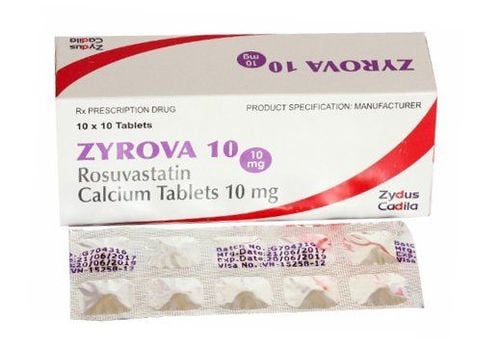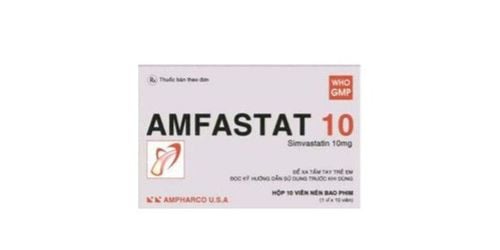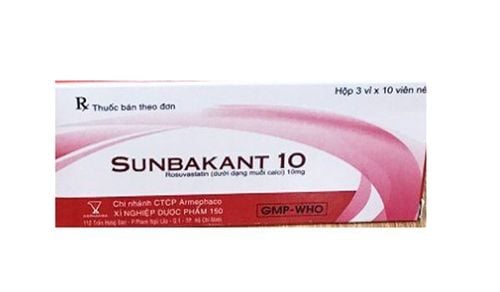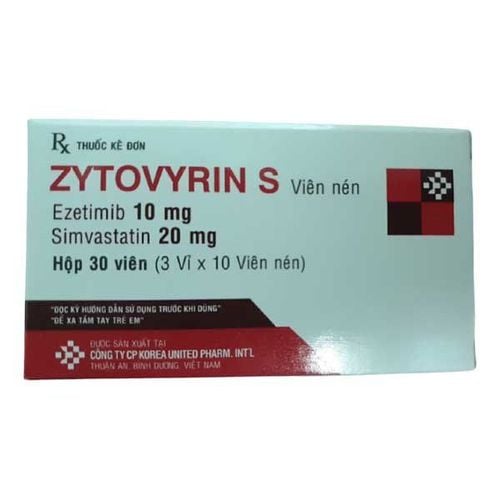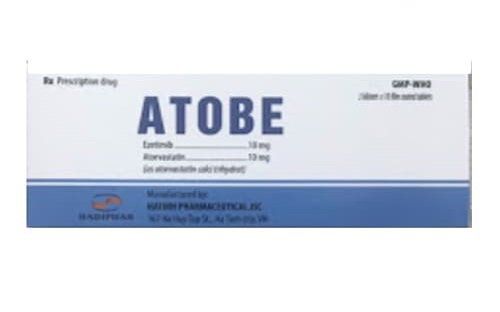This is an automatically translated article.
Eslatinb 40 is made in the form of film-coated tablets, with the main ingredient being Simvastatin. The drug is used in the treatment of hypercholesterolemia.
1. Uses of the drug Eslatinb 40
What is Eslatinb 40? What are the uses of Eslatinb 40? The active ingredient in the drug is Simvastatin 40mg. Simvastatin is a lipid-lowering drug that selectively inhibits the intestinal absorption of cholesterol and related plant sterols, inhibiting endogenous cholesterol synthesis.
Indications for the use of Eslatinb 40:
Treatment of hypercholesterolemia: Support for dietary therapy to help reduce total cholesterol and LDL cholesterol in patients with primary hypercholesterolemia, triglycerides are slightly reduced; Primary prevention of coronary events, reducing the risk of coronary heart disease, myocardial infarction, or death from cardiovascular disease; Treatment of atherosclerosis: Slow down the progression of coronary atherosclerosis, reduce the risk of acute coronary events. Contraindications to use Eslatinb 40:
Patients with hypersensitivity to Simvastatin or other components of the drug; Patients with active liver disease or unexplained persistent elevations in serum transaminases; Pregnant women and mothers in the lactation period; Co-administration of Simvastatin with strong CYP3A4 inhibitors such as: Posaconazole, Voriconazole, Itraconazole, Ketoconazole, HIV protease inhibitors, Boceprevir, Erythromycin, Clarithromycin, Telaprevir, Telithromycin and Nefazodone.
2. Usage and dosage of Eslatinb 40
Usage: Orally. The drug is used for adults and children 10 years of age and older.
Dosage: Limit dose is 1-2 tablets/day, take a single dose in the evening. If necessary, the patient can adjust the dose, after using the drug for 4 weeks with a maximum of 2 tablets / day, taken in the evening. The dose of 2 tablets / day is only used for patients with severe hypercholesterolemia, at high risk of cardiovascular complications, who do not achieve treatment results on low doses and the benefits of use outweigh the risks.
Specific dosage is as follows:
Hypercholesterolemia: Patients should follow a low cholesterol diet before taking the drug, continue to maintain this diet throughout the time of taking the drug. Patients with LDL-C (more than 45%) should start with 1 tablet/day, take a single dose in the evening and adjust the dose if necessary as prescribed above; Inherited hypercholesterolemia: Take the recommended dose of 1 tablet/day in the evening; Prevention of cardiovascular disease: Take 1 tablet/day, take a single dose in the evening. In patients at high risk for coronary heart disease, the dose may be adjusted if necessary as specified above; Patients with renal impairment: If the renal impairment is moderate and mild, the patient does not need to adjust the dose of the drug; Elderly: No dose adjustment is required; People from 10 to 17 years old: Should follow a low cholesterol diet before taking Eslatinb 40 and need to follow this diet throughout the treatment period. Maximum dose of 1 tablet / day, used in the evening. Missed dose: If a dose of Eslatinb 40 is forgotten, the patient should take it as soon as possible. If it is almost time for your next dose, skip the missed dose and take your next dose at the scheduled time.
Overdose: In case of emergency or overdose when taking Eslatinb 40, the patient should immediately notify the doctor or go to the nearest hospital for examination and treatment immediately.
3. Side effects of Eslatinb 40
Some side effects patients may encounter when using Eslatinb 40 include:
Blood and lymphatic system disorders: Anemia; Nervous system disorders: Headache, dizziness, peripheral neuropathy, paresthesia, memory impairment, insomnia, depression; Respiratory, thoracic and mediastinal disorders: Interstitial lung disease; Digestive disorders: Abdominal pain, flatulence, constipation, diarrhea, dyspepsia, nausea, vomiting, pancreatitis; Hepatobiliary disorders: Jaundice, hepatitis, liver failure; Skin and subcutaneous tissue disorders: Skin itching, rash, hair loss; Musculoskeletal - Joint and Connective Tissue Disorders: Myopathy (including myositis), myalgia, rhabdomyolysis, cramps, necrosis-mediated immunity; Reproductive disorders: Erectile dysfunction; General disorder: Myasthenia gravis. In addition, patients may also experience hypersensitivity syndrome when using Eslatinb 40 with symptoms including: Lupus-like syndrome, angioedema, dermatitis, vasculitis, polymyalgia rheumatica, leukopenia eosinophilia, thrombocytopenia, arthritis, joint pain, increased ESR, urticaria, fever, photosensitivity, skin flushing, shortness of breath, malaise,...
Patients should inform their doctor about the side effects encountered when using Eslatinb 40 for timely and effective treatment interventions.
4. Be careful when using Eslatinb 40
Some notes that patients need to remember before and while using Eslatinb 40 include:
Do not use Eslatinb 40 for pregnant and lactating women; Use Eslatinb 40 with caution in driving and operating machinery; The component Simvastatin in Eslatinb 40 may increase serum transaminase and creatinine phospholinase concentrations. Therefore, care should be taken in the differential diagnosis of patients with chest pain during treatment with this drug; Monitor liver function during treatment with Eslatinb 40; Patients with unexplained muscle pain or weakness during the use of Eslatinb 40 should contact their doctor; Use caution when using Eslatinb 40 in people who drink a lot of alcohol and have a history of liver disease; The safety and effectiveness of Eslatinb 40 have not been studied in pediatric subjects.
5. Eslatinb 40 . drug interactions
Some drug interactions of Eslatinb 40 include:
Do not combine Eslatinb 40 with drugs: Strong inhibitors of CYP3A4 (ketoconazole, posaconazole, itraconazole, erythromycin, clarithromycin, boceprevir, telithromycin, HIV protease inhibitors, telaprevir, nefazodone) , Gemfibrozil, Cyclosporin, Danazol; Concomitant use of Eslatinb 40 with Amiodarone increases the risk of myopathy, rhabdomyolysis; Concomitant use of Eslatinb 40 with Cholestyramine reduced mean AUC of total ezetimibe by up to 55%l Concomitant use of Eslatinb 40 with calcium channel blockers increased the risk of myopathy and rhabdomyolysis; Concomitant use of Eslatinb 40 with Fusidic Acid increases the risk of myopathy; Concomitant administration of Eslatinb 40 with colchicine in patients with renal impairment increases the risk of myopathy and rhabdomyolysis. Therefore, careful clinical monitoring is recommended in patients receiving these combinations; Avoid drinking too much grapefruit juice Eslatinb 40. During the use of Eslatinb 40, patients should coordinate with all indications of the doctor. If there are any unusual symptoms, the patient should immediately notify the doctor for early intervention and treatment, to avoid unpredictable risks.
Follow Vinmec International General Hospital website to get more health, nutrition and beauty information to protect the health of yourself and your loved ones in your family.
Please dial HOTLINE for more information or register for an appointment HERE. Download MyVinmec app to make appointments faster and to manage your bookings easily.




